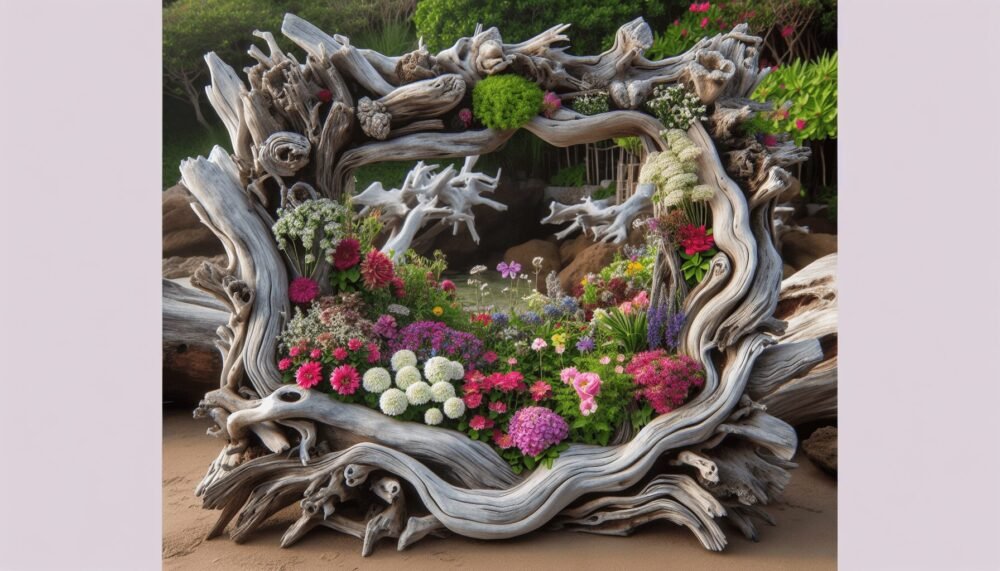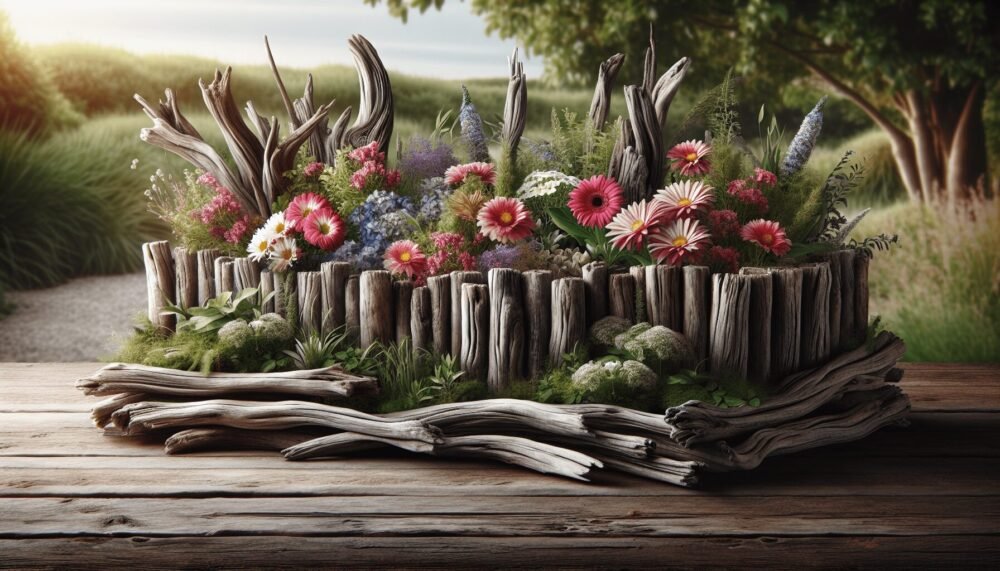Imagine stepping into your garden and being greeted by the enchanting sight of a Driftwood Flower Bed, where nature’s raw beauty meets your creative touch. This delightful garden piece utilizes the rustic elegance of driftwood to frame vibrant blossoms, creating a harmonious blend of textures and colors. It’s an eco-friendly project that repurposes naturally weathered wood, giving it a second life as a stunning focal point in your outdoor space. In this article, you’ll discover how to design and assemble your own driftwood flower bed, transforming ordinary gardening into an artful expression of nature’s charm.
Driftwood Flower Bed
Have you ever found yourself mesmerized by a piece of driftwood, pondering the journey it must have taken to land in your hands? If you’re someone who’s captivated by the natural beauty and curious history of driftwood, you might be thrilled to discover a creative way to bring this charm into your garden. Imagine transforming weathered pieces of wood into a stunning flower bed that not only nourishes your favorite plants but also adds a rustic, coastal aesthetic to your outdoor space. Sounds fascinating, right?
What is Driftwood?
Driftwood forms when wood from trees and plants gets washed out to sea or into rivers, lakes, or other bodies of water. Over time, the water and sand wear the wood down, giving it a smooth, sculptural quality. The unpredictable shapes and sizes of driftwood pieces make each one a unique, artistic element capable of transforming any garden area.
Benefits of Using Driftwood in Your Garden
Using driftwood in your garden has more benefits than just its aesthetic appeal. Here are a few compelling reasons to incorporate this natural material into your outdoor design:
- Sustainability: Driftwood is eco-friendly and repurposes fallen trees.
- Durability: Naturally treated by water, driftwood is often more resilient than fresh wood.
- Versatility: From rustic to modern styles, driftwood complements any garden theme.
Planning Your Driftwood Flower Bed
Before diving into creating your driftwood flower bed, it’s imperative to plan carefully. Proper planning ensures that your project is successful and meets your expectations.
Choosing the Right Location
Deciding where to place your driftwood flower bed is essential. Look for a spot that receives the right amount of light for the type of plants you intend to grow. Here are some questions to consider:
- How much sunlight does the area get?
- Is the area sheltered from strong winds?
- Are there existing plants or architectural features nearby?
Selecting Your Driftwood Pieces
Next up is selecting the driftwood pieces you’ll use. The beauty of driftwood lies in its natural variation, so no two pieces are the same. When choosing your driftwood, keep the following in mind:
- Size and shape: Consider the dimensions and the overall shape to ensure they fit well together.
- Condition: Look for well-weathered, non-rotting pieces.
- Texture and color: Choose pieces that complement your garden’s color palette.
Gathering Tools and Materials
Creating a driftwood flower bed requires some essential tools and materials. Here’s a list to get you started:
| Tool | Purpose |
|---|---|
| Shovel | Digging and planting |
| Garden gloves | Protection for your hands |
| Wheelbarrow | Transporting materials |
| Drill and screws | Securing driftwood pieces |
| Soil and compost | Planting medium |

Building Your Driftwood Flower Bed
Once you’ve planned, chosen your location, and gathered your materials, it’s time for the exciting part: building your driftwood flower bed. Below are detailed steps to guide you through the process.
Preparing the Ground
Start by prepping the area where you plan to build your flower bed. Clear any grass, weeds, or debris. Use your shovel to break up and turn over the soil. If the soil quality is poor, consider adding compost or a soil conditioner to improve its fertility.
Laying Out the Driftwood
Position your driftwood pieces on the ground to outline the perimeter of your flower bed. Arrange them to fit together in a way that is both secure and aesthetically pleasing. You can create geometric shapes like squares or rectangles, or go for a more organic, freeform design.
Securing the Driftwood
Once you’re satisfied with the layout, start securing the driftwood pieces together. Use a drill and screws to fasten pieces where necessary, especially at the corners and joints. This step ensures that your constructed border stays in place and withstands weather conditions.
Filling the Bed with Soil
With the structure in place, fill the flower bed with a mix of topsoil and compost. This mixture provides the necessary nutrients for your plants to thrive. Make sure the soil is evenly distributed and at the right level within the driftwood border.
Choosing Plants for Your Driftwood Flower Bed
The success of your flower bed hinges significantly on the types of plants you select. Here are some popular choices that work wonderfully in driftwood flower beds:
Native Plants
Opting for native plants can enhance the sustainability of your garden. Native plants are well-adapted to your local climate and soil conditions, requiring less maintenance. Additionally, they attract beneficial wildlife like pollinators.
Perennials
Perennials are plants that return year after year, making them a cost-effective choice for your flower bed. Examples include:
- Echinacea (Coneflowers)
- Hostas
- Lavender
Annuals
Annuals offer vibrant blooms and can be changed every year to refresh your garden’s appearance. Some favorites are:
- Petunias
- Marigolds
- Zinnias

Maintaining Your Driftwood Flower Bed
Creating your driftwood flower bed is just the beginning. Maintaining it ensures that it remains a stunning focal point in your garden. Here’s how to keep it in top shape:
Watering
Different plants have different watering needs. Some require daily watering, while others thrive on less frequent moisture. Familiarize yourself with the needs of your selected plants. Generally, it’s best to water in the early morning or late afternoon to reduce evaporation.
Feeding
Even the best soil loses nutrients over time. Feeding your plants with fertilizers helps them grow robustly. Organic options like compost or worm castings are excellent choices for an eco-friendly garden.
Pruning and Deadheading
Regular pruning and deadheading (removing spent flowers) encourage healthier plants and more blooms. Deadheading prevents plants from going to seed and redirects their energy into growth and flowering.
Extending the Aesthetic: Complementary Garden Features
A driftwood flower bed can stand alone as a beautiful garden feature, but combining it with other elements can elevate your outdoor space even further.
Pathways
Stone or gravel pathways can guide visitors through your garden, complementing the natural look of driftwood. Consider soft curves to keep the design fluid and organic.
Water Features
A small pond or fountain can add tranquility and an auditory dimension to your garden. Driftwood pieces can be integrated into the water feature, creating a seamless flow between different aspects of your garden design.
Seating Areas
Incorporating a seating area allows you to enjoy your driftwood flower bed up close. A rustic bench or a set of weather-resistant chairs can provide a perfect vantage point.
Common Challenges and Solutions
Even the most thoughtfully planned driftwood flower bed can present challenges. Here’s how to deal with some common issues:
Pest Infestation
Pests can wreak havoc on your garden. Regularly inspect plants for signs of insect damage or disease. Organic pest control methods like neem oil or insecticidal soap can be very effective. Introducing beneficial insects like ladybugs can also help keep pests under control.
Weed Control
Weeds compete with your plants for nutrients and water. Mulching is an effective way to suppress weeds while retaining moisture in the soil. Hand-pulling weeds regularly is a traditional but effective method.
Soil Erosion
In areas with heavy rainfall, soil erosion can become a problem. Adding mulch, ground cover plants, or even installing small retaining features made from driftwood can help keep soil in place.
Personalizing Your Driftwood Flower Bed
A driftwood flower bed doesn’t just add beauty to your garden; it can also reflect your personal style and creativity. Consider incorporating some personalized touches to make the space truly yours.
Decorative Elements
Incorporate small garden statues, shells, or decorative stones to enhance the look of your flower bed. These elements can add a whimsical touch or serve as conversation starters.
Seasonal Changes
Change up the look of your flower bed with the seasons. Plant seasonal flowers or add holiday-themed decorations to keep the space fresh and engaging all year long.
Lighting
Garden lighting can make your driftwood flower bed a focal point even at night. Solar-powered lights are an environmentally friendly option that can highlight the beauty of your garden while consuming minimal energy.
Conclusion
Creating a driftwood flower bed is a rewarding project that brings the beauty of the coast into your garden. It combines the rugged, natural aesthetics of driftwood with the vibrant life of a blooming garden. By planning carefully, choosing the right plants, and maintaining your bed, you can create a space that not only looks stunning but also provides a serene place to relax and enjoy nature.
Remember, every piece of driftwood tells a story, and now you have the chance to write the next chapter in your garden. Happy gardening!
This article aimed to give you a comprehensive guide to creating and maintaining a driftwood flower bed. The steps provided are detailed yet straightforward, ensuring that by the end of this project, you’ll have crafted a unique and beautiful addition to your garden. Whether you’re a seasoned gardener or a newbie, the adventure of building a driftwood flower bed is sure to be a memorable and enriching experience. Enjoy the journey and the countless blooms that lie ahead!